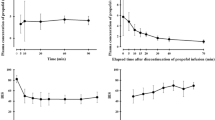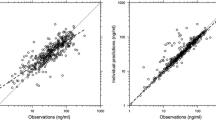Abstract
The pharmacokinetic-pharmacodynamic model developed here characterizes the relationship between simulated plasma concentrations of thiopental and two dichotomous endpoints determined at induction of anesthesia: loss of voluntary motor power (clinical endpoint), and burst suppression of the electroencephalogram (EEG endpoint). The model incorporated data from two separate thiopental patient studies: a pharmacokinetic study with 21 males, and a pharmacodynamic study with 30 males. In the pharmacodynamic study, cumulative quantal dose-response curves for the clinical and EEG endpoints were developed from observations made during a constant-rate infusion of thiopental. Population mean parameters, derived from the bolus pharmacokinetic thiopental study, were used to simulate concentration-time data for the 150 mg·min1 thiopental infusion rate used in the dose-response study. A single biophase model incorporating the two endpoints was generated, combining the pharmacokinetic and pharmacodynamic data from the two groups. Estimates of the mean effective thiopental concentrations affecting 50% of the population (EC50s) for the clinical and EEG endpoints were 11.3 and 33.9μg·ml−1, respectively. The half-time for equilibration between arterial thiopental and the effect compartment was 2.6 min. These results are in reasonable agreement with previously described quantal concentration-response data, and with pharmacodynamic models developed for graded EEG responses. Simulation of bolus doses of thiopental with the new model provided ED50s for the clinical and EEG endpoints of 265 mg and 796 mg, respectively; the dose predicted to produce loss of voluntary motor power in 90% of an adult male population was 403 mg. A model combining population pharmacokinetics with cumulative dose-response relationships could prove useful in predicting dosage regimens for those drugs with responses that are categorical.
Similar content being viewed by others
References
L. B. Sheiner, D. R. Stanski, S. Vozeh, R. D. Miller, and J. Ham. Simultaneous modeling of pharmacokinetics and pharmacodynamics: Application tod-tubocurarine.Clin. Pharmacol. Ther. 25:358–371 (1979).
M. J. Avram, T. C. Krejcie, and T. K. Henthorn. The relationship of age to the pharmacokinetics of early drug distribution: The concurrent disposition of thiopental and indocyanine green.Anesthesiology 72:403–411 (1990).
M. J. Avram, R. Sanghvi, T. K. Henthorn, T. C. Krejcie, C. A. Shanks, R. J. Fragen, K. A. Howard, and D. A. Kaczynski. Determinants of thiopental induction dose requirements.Anest. Analg. 76:10–17 (1993).
M. J. Avram and T. C. Krejcie. Determination of sodium pentobarbital and either sodium methohexital or sodium thiopental in plasma by high performance liquid chromatography with ultraviolet detection.J. Chromatog. 414:484–491 (1987).
M. Berman and M. Weiss.SAAM Users Manual, DHEW Publication (NIH), Bethesda, Md., 1978.
R. C. Boston, P. C. Grief, and M. Berman. Conversational SAAM—an interactive program for kinetic analysis of biological systems.Comput. Prog. Biomed. 13:111–119 (1981).
A. Lyne, R. Boston, K. Pettigrew, and L. Zech. EMSA: a SAAM service for the estimation of population parameters based on model fits to identically replicated experiments.Comput. Meth. Prog. Biomed. 38:117–151 (1992).
J. A. Jaquez and T. J. Perry. Parameter estimation: local identifiability of parameters.Am. J. Physiol. 258:E727-E736 (1990).
T. K. Henthorn, M. J. Avram, T. C. Krejcie, C. A. Shanks, A. Asada, and D. A. Kaczynski. Minimal compartmental model of circulatory mixing of indocyanine green.Am. J. Physiol. 262:H903-H910 (1992).
D. P. Crankshaw and J. Allt-Graham. ED50 values for thiopentone, methohexital, propanidid and alfathesin: A clinical experiment.Anaesth. Intensive Care 6:36–43 (1978).
D. K. Kiersley, R. G. Bickford, and A. Faulconer Jr. Electroencephalographic patterns produced by thiopental sodium during surgical operations: Description and classification.Br. J. Anaesth. 23:141–152 (1951).
T. C. Krejcie. Using a microcomputer to convert percent response values to probits.Int. J. Clin. Monit. Comput. 8:19–23 (1991).
K. E. Becker. Plasma levels of thiopental necessary for anesthesia.Anesthesiology 49:192–196 (1978).
L. E. Mather, L. T. Seow, J. G. Roberts, G. K. Gourlay, and M. J. Cousins. Development of a model for integrated pharmacokinetic and pharmacodynamic studies of intravenous anaesthetic agents: Application to minaxolone.Eur. J. Clin. Pharmacol. 19:371–381 (1981).
D. R. Stanski, R. J. Hudson, T. D. Homer, L. J. Saidman, and L. Meathe. Pharmacodynamic modeling of thiopental anesthesia.J. Pharmacokin. Biopharm. 12:223–240 (1984).
T. D. Homer and D. R. Stanski. The effect of increasing age on thiopental disposition and anesthetic requirement.Anesthesiology 62: 714–724 (1985).
D. R. Stanski and P. O. Maitre. Population pharmacokinetics and pharmacodynamics of thiopental: The effect of age revisited. Anesthesiology72:412–422 (1990).
O. R. Hung, J. R. Varvel, S. L. Shafer, and D. R. Stanski. Thiopental pharmacodynamics II. Quatitation of clinical and electroencephalic depth of anesthesia.Anesthesiology 77:237–244 (1992).
J. H. Christensen and F. Andreasen. Individual variation in response to thiopental.Acta Aneasth. Scand. 22:303–313 (1978).
S. Muravchick. Effect of age and premedication on thiopental sleep dose.Anesthesiology 61:333–336 (1984).
M. Naguib, A. Sari-Kouzel, M. Seraj, M. El-Gammal, and M. Gomma. Induction dose-response studies with propofol and thiopentone.Br. J. Anaesth. 68:308–310 (1992).
J. R. Jacobs and J. G. Reves. Effect site equilibration time is a determinant function of dose requirement.Anesth. Analg. 76:1–6 (1993).
Author information
Authors and Affiliations
Rights and permissions
About this article
Cite this article
Shanks, C.A., Avram, M.J., Krejcie, T.C. et al. A pharmacokinetic-pharmacodynamic model for quantal responses with thiopental. Journal of Pharmacokinetics and Biopharmaceutics 21, 309–321 (1993). https://doi.org/10.1007/BF01059782
Received:
Revised:
Published:
Issue Date:
DOI: https://doi.org/10.1007/BF01059782




